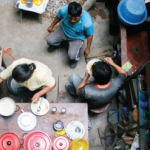Dr. Callahan currently mentors graduate students on research projects and serves on dissertation committees at UNC. She is a member and past president of the ARHP and has written numerous published articles and frequently speaks at conferences about her findings.
Linda Ehrlich-Jones, PhD, RN, a clinical research scientist at the Rehabilitation Institute of Chicago and immediate past president of ARHP, describes Dr. Callahan as a fantastic researcher who is personable and always willing to help. “She appears to be laid-back, but she is obviously very productive and works very hard at what she does,” says Dr. Ehrlich-Jones. “She is very kind, helpful, and giving.”
Fun for Dr. Callahan is watching her favorite basketball team, the UNC Tar Heels, and conducting research. She strives to demonstrate to students that research is “a lot of fun” as well as a worthy pursuit.
“I think it appeals to my sense of justice. I think we need to be, as a society, thinking about how we can have the best possible health outcomes for everybody,” says Dr. Callahan.
She says her interest in health disparities has snowballed over the years as the situation in the United States worsened, especially when compared with other countries. “There’s a lot of evidence that, the wider the gap between the rich and the poor, the worse the health of the whole nation is,” she says.
Very often, people with a low economic status also have minimal health literacy; their level of education mirrors how well they can obtain and understand information about their health. Obviously it’s not possible, says Dr. Callahan, to send everyone back to high school to get a degree, but research can serve as a catalyst to change public policy so that better health interventions are adopted.
Health Outcomes and Where One Lives
Over the years, Dr. Callahan has expanded her research to look at other indicators of socioeconomic status and how they interplay with health outcomes. In a paper published recently in Arthritis Care & Research, she looked at education, home ownership, income, and occupation, all of which can predict disease outcome, she says.1 Her research showed that individuals who had a household annual income less than $45,000 had poorer health status than those who had an income greater than $45,000. However, a good education and income does not assure good health if you are surrounded by poverty, says Dr. Callahan. “We also find that where we live makes a difference,” she notes.
From a public health perspective, I really like the idea of thinking about … interventions that are outside the medical system that people can do that will make a difference in the outcomes of their arthritis.
Research shows that if you live where a large number of people are living below the poverty line, even if you have a high level of education, you will have a worse outcome, says Dr. Callahan.

